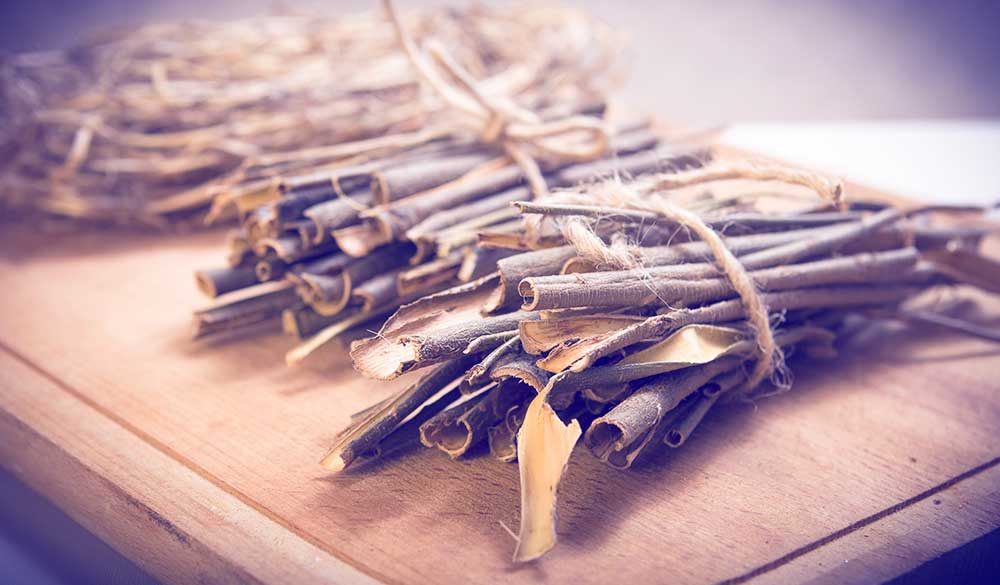Salix alba, commonly known as white willow, is most well-known for its anti-inflammatory, analgesic and antioxidant properties particularly in the areas of osteoarthritis (OA), joint pain and chronic lower back pain.[1,2] The use of this herb dates back over 3,500 years[3] in regions including the Mediterranean, China, North America, South America and the Caribbean where it was also used to help treat generalised pain, headaches, menstrual cramps, tendonitis, and symptoms of influenza, including fever.[1,3] Illustrious, however, is the apt use of white willow bark and its main active constituent, salicin, in the treatment of inflammatory pain associated with sports and exercise.[1]
While the therapeutic benefits of white willow are largely attributed to salicin,[11] salicylate-related compounds have been identified as contributing to the plant’s analgesic benefits.[1] In addition to these, various polyphenolics and flavonoids are also present, which possess high antioxidant and free radical scavenging activity. These may also contribute to the bark’s anti-inflammatory, antiseptic and immune-enhancing properties.[1] This complex mixture of active constituents also helps to explain why the required dose of salicin from white willow (120-240mg) is considerably lower than the therapeutic dose required for aspirin (500mg acetylsalicylic acid).[1]
Inflammation generated by intense exercise may benefit from the anti-inflammatory and antioxidant capacity of white willow bark extract.[1] Furthermore, the pain relief potential of white willow may assist in increasing an individual’s range of motion and resultant exercise performance; all contributing to greater athletic output and optimising weight-loss.[1]
Several studies have been conducted using white willow and its salicylates to examine pain relief and exercise performance. One study examined the administration of salicylates in improving resistance training output, and found that the decrease in perceived pain index as a result of salicylate administration resulted in significant increases in resistance training performance.[1] This effect was believed to occur due to modulation of inflammatory markers including cyclooxygenase-2 (COX-2), prostaglandins and interleukins, which when moderated play a role in inhibiting post-exercise muscle soreness.[1,4,5]
The use of pain-reducing compounds in exercise performance is well-known and has been extensively researched; further supporting the contention that exercise is at least partially regulated by pain perception. Thus, increasing pain tolerance may improve the capacity for exercise.[1,6,7]
References:
- Shara M, Stohs SJ. Efficacy and safety of white willow bark (Salix alba) extracts. Phytother Res 2015;29(8):1112-1116. [Abstract]
- Gagnier KK, van Tulder MW, Berman B. Herbal medicine for low back pain: a Cochrane review. Spine (Phila Pa 1976) 2007;32(1):82-92. [Abstract]
- Desborough MJR, Keeling DM. The aspirin story – from willow to wonder drug. B J Haematol 2017;177(5):674-683. [Abstract]
- Hudson GM, Matt GJ, Bishop PA, et al. Effects of caffeine and aspirin on light resistance training performance, perceived exertion, and pain perception. J Stren Condit Res 2008;22(6):1950-1957. [Abstract]
- Buford TW, Cooke MB, Shelmadine BD, et al. Effects of eccentric treadmill exercise on inflammatory gene expression in human skeletal muscle. Appl Physiol Nutr Metab 2009;34(4):745-753. [Abstract]
- Holgado D, Hopker J, Sanabria D, et al. Analgesics and sport performance: beyond the pain-modulating effects. PM R 2017:S1934-1482(17)30230-7. [Abstract]
- Mauger AR, Jones AM, Williams CA. Influence of acetaminophen on performance during time trial cycling. J Apply Physiol 2010;108(1):98-104. [Full Text]
DISCLAIMER:
The information provided on FX Medicine is for educational and informational purposes only. The information provided on this site is not, nor is it intended to be, a substitute for professional advice or care. Please seek the advice of a qualified health care professional in the event something you have read here raises questions or concerns regarding your health.



